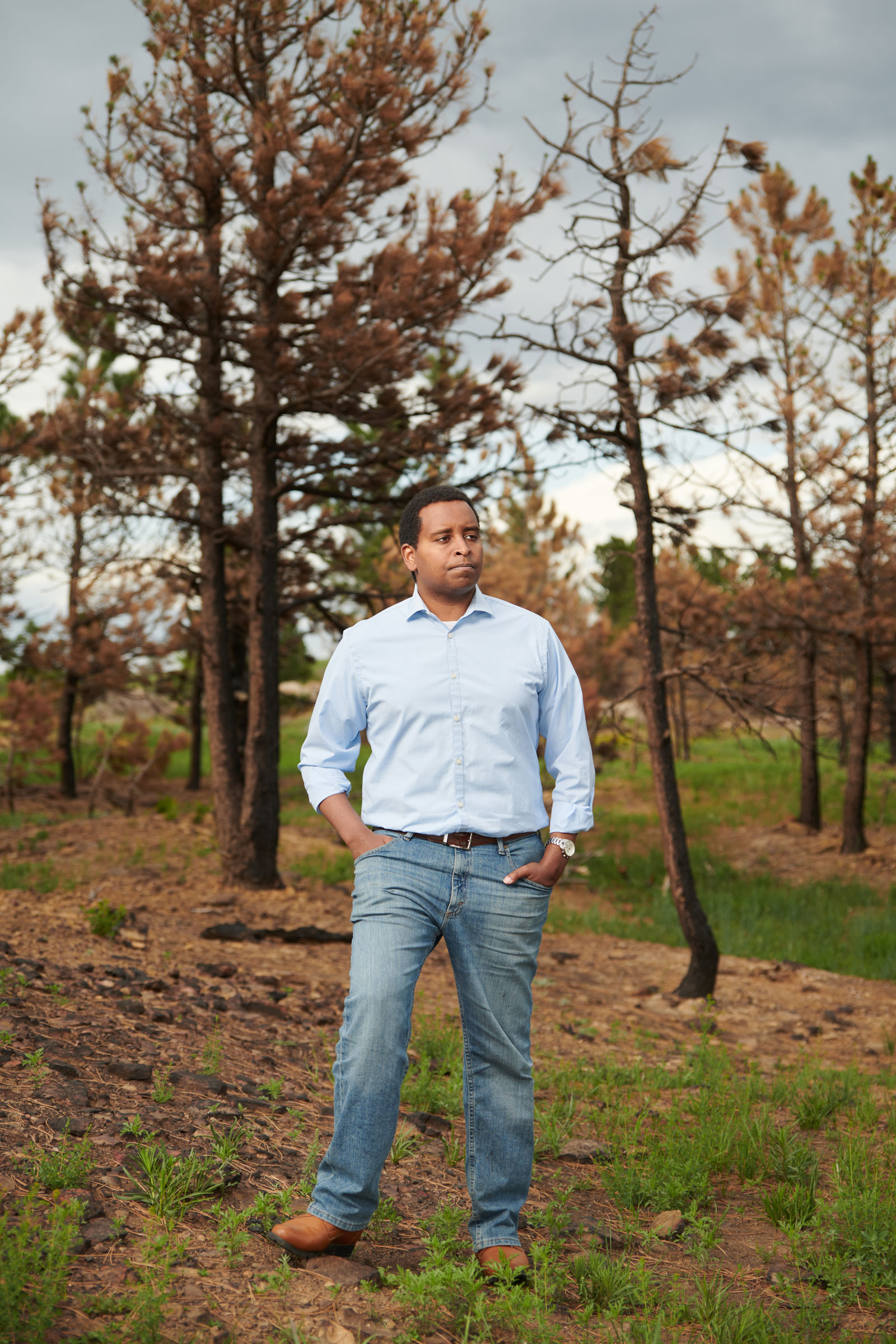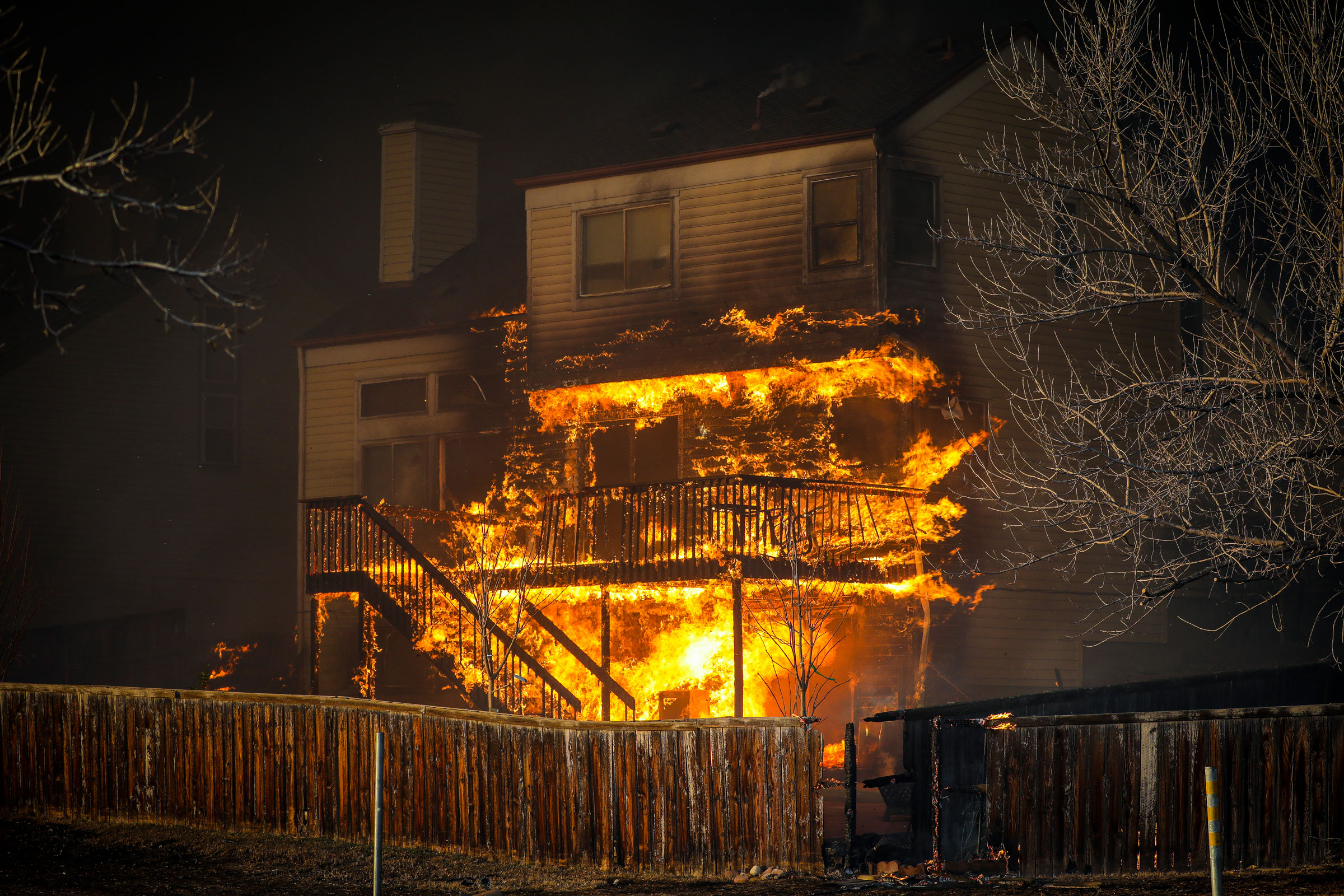
Despite clear directions from my GPS, I felt certain I was in the wrong place as I drove the last mile to meet Colorado Representative Joe Neguse in March. We were meeting in the city of Superior at the site of a recent devastating wildfire in his district, and yet the subdivisions I sped past seemed to be buzzing along normally. Shoppers drove into a shopping complex while parents ferried kids to school. But then, in the middle of idyllic suburbia, it appeared: a 30-acre subdivision in ruins. Every single home in the neighborhood, once home to nearly 200 houses, burned to the ground in the Marshall Fire in December. Now a visitor can see the outlines of where the homes used to stand and the frame of a burnt-out car here and there, but not much more remains.
Waiting at the entrance to the Sagamore subdivision stood Neguse. While I moved ploddingly through the wreckage to take it all in, Neguse, 38, jumped briskly from one spot to another, not quite cheery but not morose either. For him, touring fire wreckage has become a ritual, following a string of major fire events that rocked this part of the state over the past three years. He’s done variations on the tour more times than his office can count—with journalists, residents, and local officials, even with Joe Biden. It’s just one small indicator of how addressing wildfire fallout has become, in his words, the “primary occupation” of his office. “Because there is no fire season, this wildfire work is year-round,” he says. “It is every month, every week, every day.”
Neguse, a lawyer by training who previously oversaw Colorado’s consumer-protection agency, seems like a good fit for this bleak job. He likes to dig into details (he spoke for 16 minutes in response to one of my questions), and in the district I watched him dive into the particulars of federal recovery programs for displaced residents—from insurance policy to EPA soil-quality rules—without breaking a sweat. Still, despite his attention to the details, he says lawmakers need to pay attention to the bigger picture. “We have to fundamentally deal with the disease, not just simply the symptoms,” he says. “The disease is climate change.”
But there are only so many hours in a day. And the more time Neguse and other elected officials need to spend putting out fires, the more challenging it becomes to get to the root of the problem.
Neguse, who has lived in Colorado since he was 6, is the first to admit wildfires are nothing new for the state. He recalls hearing about wildfires as a child, but in his recollection they didn’t come close to what the state is experiencing today. Since voters in this part of the state first elected Neguse to Congress in 2018, wildfires have become an increasingly central challenge. Nine of the 20 largest fires in the state have taken place since then, and thousands of people have been displaced. The damage from the Marshall Fire alone totaled $1 billion. Neguse’s district, which includes the suburbs northwest of Denver and stretches all the way to the state’s northern border, has been hit particularly hard.
Neguse, who rose to national prominence serving as a prosecutor in President Donald Trump’s second impeachment trial, says this reality has made addressing wildfires a nonstop job. “I knew going into my service as a member of Congress that wildfires would be something that I would work on,” he told me. “But I certainly did not anticipate that it would become the defining issue of my time in Congress.”

Increasingly, frequent and deadly wildfires are a frightening reality across much of the U.S. Climate change has brought warmer temperatures and, in turn, drier forests, creating ideal conditions to spark a fire. Meanwhile, humans have built closer and closer to the wilderness where wildfires generally start. The result is an unpredictable year-round fire season with annual acreage burned creeping up dramatically over the past three decades. More than 10 million acres burned in 2020, an area more than twice the size of Connecticut; in the 1990s the average year saw just over 3 million acres burn. And while Western states like Colorado may be the hardest-hit now, scientists expect other places to follow, particularly in the Southeast.
“I am doing everything I can to ring the alarm,” Neguse says. “If a fire can ultimately tear through and destroy these suburban communities, it can happen in New Jersey, it can happen in Georgia, it could happen in Seattle—and I think that that’s a paradigm shift.”
An on-the-ground tour definitely helps him make that case. Save for the Rocky Mountains in the background, driving through Neguse’s district felt like we could have been anywhere in the U.S. In a few short hours, we bounce from one wildfire-razed subdivision to another. Only one of them bordered open land. The rest were doomed by the vagaries of the wind, which carried flames across the highway and into neighborhoods, seemingly at random. Some large buildings stand undisturbed. Others were destroyed altogether—a new 120-room hotel is now little more than an elevator shaft and some steel beams.
Neguse says he’s making headway getting lawmakers across the political spectrum onboard with meaningful wildfire policy. He succeeded in pushing for more than $5.75 billion in funding as part of last year’s bipartisan infrastructure law to invest in forest management that will reduce the risk of wildfires in some high-risk zones. With a Republican counterpart from Utah, he launched a congressional wildfire caucus.
But his most urgent initiatives may be the work his office is doing to help residents and local officials navigate the maze of federal programs and support as they try to rebuild. After my tour, Neguse dropped by a recreation center across the street from a burned-down subdivision to meet with displaced residents. One sounded angry. Another teared up. But for the most part, the gathered residents had entered a new stage of response, defined less by emotion over the wildfire and more by frustration with their efforts to rebuild. Snarled supply chains meant long waits for construction materials. A stretched housing stock meant finding a temporary place to stay was expensive. “It’s just making everything more difficult,” said Neguse.
To truly address the root cause of the spike in wildfires would mean cutting emissions, but in the meantime there are all these other fires to put out. To that end, Neguse promised to take his constituents’ challenges back to Washington. The next day, before he could leave town, yet another stumbling block got in the way: he tested positive for COVID-19, and those burning concerns would have to wait just a little longer.
More Must-Reads From TIME
- The 100 Most Influential People of 2024
- The Revolution of Yulia Navalnaya
- 6 Compliments That Land Every Time
- What's the Deal With the Bitcoin Halving?
- If You're Dating Right Now , You're Brave: Column
- The AI That Could Heal a Divided Internet
- Fallout Is a Brilliant Model for the Future of Video Game Adaptations
- Want Weekly Recs on What to Watch, Read, and More? Sign Up for Worth Your Time
Write to Justin Worland/Superior, Colo. at justin.worland@time.com